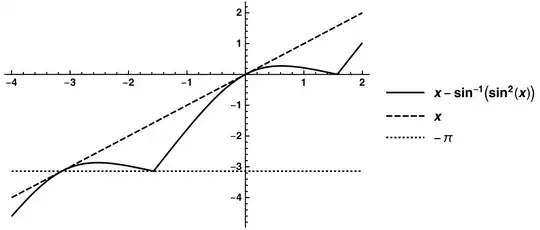For the first part we have that if $a_0=0 \implies a_n=0$ and $\sqrt n a_n =0$.
For $a_0 > 0$
$a_{n}>0 $ (by induction)
$a_{n+1}< a_n \iff a_{n+1}- a_n= -\arcsin(\sin^2a_n) < 0$
$a_n \to L$ (monotone sequence theorem)
- $L=L -\arcsin(\sin^2L) \implies L=0$
For $a_0 < 0$ let consider $b_n=\pi+a_n>0$ then
$$a_{n+1}=a_n-\arcsin(\sin^2a_n) \iff b_{n+1}=b_n-\arcsin(\sin^2b_n)$$
that is $a_n \to -\pi$.
For the second part, for the case $a_0>0$, let consider $na_n^2$ and by Stolz-Cesaro we have
$$na_n^2=\frac n{\frac1{a_n^2}} \implies \frac{n+1-n}{\frac1{a_{n+1}^2}-\frac1{a_n^2}}=\frac{a_{n+1}^2a_n^2}{a_n^2-a_{n+1}^2}\sim \frac{(a_n-a_n^2)^2a_n^2}{a_n^2-a_n+a_n^2}=\frac{(a_n-a_n^2)a_n}{2a_n-1} \to 0$$
and therefore $\sqrt n a_n \to 0$.
By a rough evaluation we can also claim that $a_n\sim \frac 1n$ indeed by $a_n\sim cn^\alpha$
$$c(n+1)^\alpha= cn^\alpha-\arcsin(\sin^2a_n)\sim cn^\alpha-c^2n^{2\alpha}$$
$$\left(1+\frac1n\right)^\alpha -1 \sim-cn^{\alpha} \implies 1+\frac{\alpha}n -1 \sim-cn^{\alpha} \implies c=1,\,\alpha=-1$$
indeed again by Stolz-Cesaro we have
$$na_n=\frac n{\frac1{a_n}} \implies \frac{n+1-n}{\frac1{a_{n+1}}-\frac1{a_n}}=\frac{a_{n+1}a_n}{a_n-a_{n+1}}\sim \frac{(a_n-a_n^2)a_n}{a_n-a_n+a_n^2}=1-a_n \to 1$$
